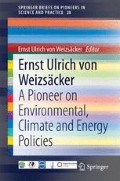Access this chapter
Tax calculation will be finalised at checkout
Purchases are for personal use only
Notes
- 1.
This chapter was drafted and presented at a time when knowledge about the problems of agricultural genetic engineering was in its infancy. A mere ten years later, the alleged benefits e.g. of incorporating the BT toxin into crops had become very doubtful. At the time of republishing this piece in an anthology of the author’s writings, i.e. in 2014, the thrust of an article written on this topic would have been completely different. E.v.W. 2014.
- 2.
This text was published in: Davies, Duncan, (Ed.), 1986: Industrial Biotechnology in Europe (Brussels: Centre for European Policy Studies): 35–45. The permission to republish this text was granted by Ms. Margarita Minkova on behalf of CEPS on 5 February 2014.
- 3.
European Parliament, Working Document A 2-109/85/B; European Parliament, Working Document A 2-110/85; European Parliament, Working Document A 2-108/85; European Parliament, Working Document A 2-89/85; European Parliament, Working Document A 2-106/85; European Parliament, Working Document A 2-99/85.
- 4.
Kolata, Gina, 1986: “How Safe are Engineered Organisms?”, in: Science, 229: 34–35. (Brief article on the Philadelphia Conference on Engineered Organisms in the Environment: Scientific Issues, 10–13 June 1985).
- 5.
Kolata, Gina, op. cit. See also Brill, W. 1985: “Safety Concerns and Genetic Engineering in Agriculture”, in: Science, 227: 381–384, and the table of US R&D programmes for herbicide-resistant plants, in: Genetic Technology News, April 1984.
- 6.
For a balanced discussion of this much debated point, see Pimm, Stuart L. 1984: “The Complexity and Stability of Ecosystems”, in: Nature, 307: 321–326.
- 7.
von Weizsäcker, Ernst, “Konsequenzen der Gentechnologie aus der Sicht moderner Evolutionstheorie”, written and oral evidence to the Commission of Inquiry of the Federal Republic of Germany Bundestag on “Prospects and Risks of Genetic Engineering” (“Chancen und Risiken der Gentechnologie”).
- 8.
Proposal for a Coordinated Framework for Regulation of Biotechnology, Office of Science and Technology Policy Notice, 31 Dec 1984.
- 9.
An important response was: Covello, Vincent T.; Fiksel, Joseph R. (Eds.), 1985: The Suitability and Applicability of Risk Assessment Methods for Environmental Applications of Biotechnology (Washington, DC: National Science Foundation).
- 10.
See a draft paper: “Community Regulations Impinging on Biotechnology”, BSC/4/2.4.2, March 1985, available from the Concertation Unit for Biotechnology in Europe (Brussels: Commission of the EC, 1985).
- 11.
This refers to the step-by-step, cumulative ‘learning’ approach, c.f. Clark, William C. 1980: Witches, Flood and Wonder Drugs. Historical Perspectives on Risk Management (Vancouver: University of British Columbia, Institute of Resource Ecology).
References
Botho, Böhnke, 1982: “Mit Bakterien-Kolonien gegen verschmutzte Abwässer”, RWTH-The men (Aachen: Technische Universität), No. 2: 10–12.
K. Buchholz et al., 1985: “Technischer Fortschritt und fortschrittliche Technik: Wie nützlich ist die Gentechnologie?”, Materialien der Studiengruppe “Gesellschaftliche Folgen neuer Biotechniken” der Vereinigung Deutscher Wissenschaftler: Mimeo: 19–27.
D. Ghosal, I.-S. You, D.K. Chatterjee, A.M. Chakrabarty, 1985: “Microbial Degradation of Halogenated Compounds”, in: Science, 228: 135–142.
H. Hauptti et al., 1985: “Genetically Engineered Plants: Environmental Issues”, in: Bio/Technology, 3: 437–442.
Peter, Kramer, 1982: “Biotische Viefalt: Ihre Evolution, ökologische Steuerung und Beeinflussung durch den Menschen”, Habil.Schrift, Universität Essen.
Josef St. Schell: “Leben mit fremden Genen”, in: Naturwiss. Rundschau, 36: 254–260.
Maro, Sondahl; William, Sharp; David, Evans, 1985: “Biotechnology for Agriculture of Third World Countries”, in: ATAS Bulletin, Tissue Culture Technology and Development (New York: United Nations).
Shigetu Tsuru/Helmut Weidner, 1985: Ein Modell für uns: Die Erfolge der japanischen Umweltpolitik (Köln: Kiepenheuer & Witsch).
K.N. Timmis et al., 1985: “Analysis and Manipulation of Plasmid-Encoded Pathways for the Catabolism of Aromatic Compounds by Soil Bacteria”, in: Donald R. Helsinki et al. (eds.): Plasmids in Bacteria (Pleumin: 719–739).
Author information
Authors and Affiliations
Corresponding author
Editor information
Editors and Affiliations
Rights and permissions
Copyright information
© 2014 The Author(s)
About this chapter
Cite this chapter
von Weizsäcker, E.U. (2014). The Environmental Dimension of Biotechnology. In: von Weizsäcker, E. (eds) Ernst Ulrich von Weizsäcker. SpringerBriefs on Pioneers in Science and Practice, vol 28. Springer, Cham. https://doi.org/10.1007/978-3-319-03662-5_6
Download citation
DOI: https://doi.org/10.1007/978-3-319-03662-5_6
Published:
Publisher Name: Springer, Cham
Print ISBN: 978-3-319-03661-8
Online ISBN: 978-3-319-03662-5
eBook Packages: Earth and Environmental ScienceEarth and Environmental Science (R0)

